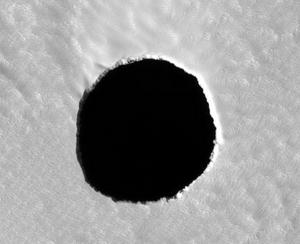The 150- by 157-metre feature was first noticed in an image taken by NASA's Mars Reconnaissance Orbiter on 5 May 2007 using a camera called the High Resolution Imaging Science Experiment (HiRISE).
Viewed from directly overhead, the dark spot showed no evidence of walls or a floor, leading some HiRISE scientists to suspect it was the opening to a cavern.

|
| ©NASA/JPL/University of Arizona |
| The first image of the dark feature showed no signs of any walls, leaving open the possibility that it was the entrance to a larger cavern. |
That would have been exciting, since caves might be good places to search for life, as they offer protection from intense ultraviolet radiation from the Sun. Caves could also provide shelter for any future human visitors to Mars.
The new image, however, suggests the feature is just a vertical shaft cutting into the surface. Taken on 8 August from a different angle, the image reveals a wall on the feature's eastern side.

|
| ©NASA/JPL/University of Arizona |
| A new image reveals a wall on this dark feature, suggesting it is a pit at least 78 metres deep. |
Bouncing robots
It is not clear how deep the pit is, because its floor has still not been seen. But the HiRISE team says it must be at least 78 metres deep.
Similar "pit craters" form on the flanks of volcanoes in Hawaii when lava deep underground drains away, causing the overlying rock to collapse downward, forming a well.
Although this particular feature did not turn out to be a cave entrance, Mars may have caves in the form of intact "lava tubes" - long tube-shaped cavities sometimes left behind when underground lava drains away. Some collapsed lava tubes are known on Mars and intact ones may well be present too.
Scientists have designed small bouncing robots that could one day investigate Martian caves.



it could be an entrance/exit to an underground installation of some sort.